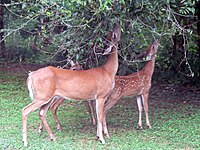
Photo from wikipedia
ABSTRACT Wild mammalian herbivores can compete with domestic livestock and damage other types of production systems. We reviewed damage by wild mammalian herbivores, excluding rodents, to primary production in New… Click to show full abstract
ABSTRACT Wild mammalian herbivores can compete with domestic livestock and damage other types of production systems. We reviewed damage by wild mammalian herbivores, excluding rodents, to primary production in New Zealand and assessed whether primary producers alter stocking rates in response to changes in forage availability following pest control. Given the dearth of information on the damage caused by wild mammalian herbivores to many production systems, we primarily focused on their damage to agriculture. With the exception of the substantial damage that brushtail possums (Trichosurus vulpecula) and European rabbits (Oryctolagus cuniculus) cause, there are no quantitative estimates of pasture depletion by other wild mammalian herbivores on New Zealand farmland. Estimates of dry matter consumption by wild mammalian herbivores, converted to stock unit equivalents, suggest that several species can substantially reduce stocking rates when they occur on farmland. Quantitative data on the damage they cause to horticulture and silviculture are lacking, but damage to coniferous seedlings has been recorded for possums, wallabies (Notamacropus spp.), and some species of deer (Cervus spp., Rusa spp., and Dama dama). The process that primary producers use to decide whether to control wild mammalian herbivores includes complex social and economic factors, but quantitative information is important for weighing up the expected costs and benefits of pest control. However, it is unclear how primary producers manage livestock in response to increases in forage availability following pest control. The paucity of quantitative data on wild mammalian herbivore damage to production assets is a substantial knowledge gap. Key research priorities are (i) understanding how damage varies with pest density (critical information for effective pest management) and (ii) and how primary producers alter stocking rates following reductions in pest density.
Journal Title: New Zealand Journal of Zoology
Year Published: 2019
Link to full text (if available)
Share on Social Media: Sign Up to like & get
recommendations!